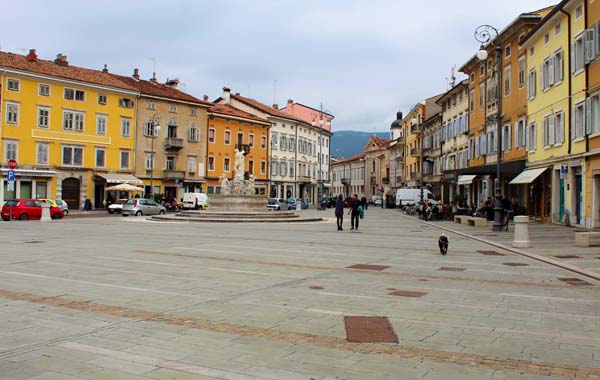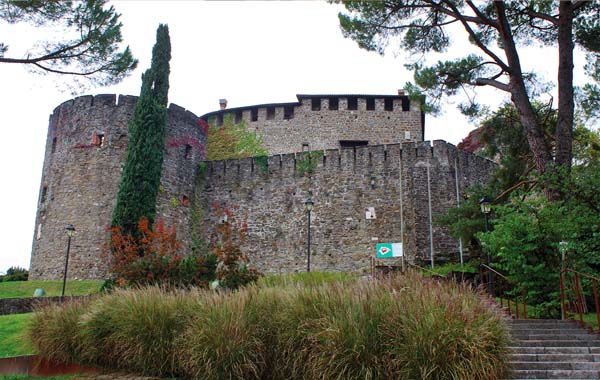Amy McPherson steps into Gorizia’s multilayered culture to discover a charming fusion city…
Photos by Amy McPherson unless otherwise stated

Gorizia is one of those border cities that doesn’t feel quite one or the other. On the one hand, it is characteristically Italian: emotions are thrown around in the wild gestures of hands. Yet there is also a splash of Austro-Hungarian grandeur in the architecture, as well as a sense of the delicate, soft nature of Slovene culture.
First documented in 1001 AD, Gorizia has always been at the crossroads of Latin, Slavic and Germanic influences. Its Italian name comes from the Slovene word gorica, which means “little hill”. The Slovenes now call it Stara Gorica, which means Old Gorizia, to distinguish it from the new town, Nova Gorizia, which was developed on the other side of the border after the second world war.
Gorizia (Stara Gorica) is in Italy’s Friuli-Venezia Giulia region, and has been since 1947, when it was ceded to Italy by the newly-formed Yugoslavia. It was then that President Tito ordered the construction of Nova Gorica. The conurbation, which also includes Šempeter-Vrtojba, remained very much a border town for over half a century, until the implementation of the Schengen Agreement in 2007. Today you hardly notice the border, but you can see that the fusion of the city’s personality runs deep.
GRAND MANSIONS
Despite its name, Corso Italia, the main boulevard from the train station to the city centre, actually seems more Austrian than Italian. The rows of grand mansions are from the Habsburg era, which continued here until the first world war, and are mostly styled in the elegance of Viennese architecture. This gained Gorizia the nickname of “the Nice of Austria”, as the city, with its mild microclimate, became a popular country-house hotspot for wealthy merchants from Venice and Trieste, many of who came here for the peace and quiet of the countryside, and to enjoy the region’s fine wines.
Today you hardly notice the border, but you can see that the fusion of the city’s personality runs deep.
My brief survey of the style of treats on offer here starts to give me a better idea of the depth of the multi-layered culture that exists in this border city.
I continue along Corso Italia into the main hub of the city, passing cafés, restaurants, boutiques, gelatarias and parks to reach the vibrant junction by Mercato Coperto. It is mid-morning and the cafés surrounding the market are busy with people taking their midmorning espresso break. I have a quick look around the covered market and find an array of local produce and temptations. My brief survey of the style of treats on offer here starts to give me a better idea of the depth of the multi-layered culture that exists in this border city. At the Pane e Dolci Artigianali Gorizia bakery at the corner of the market, for example, I find Italian-style focaccias and almond biscotti alongside filled doughnuts and dense breads of Austrian origin, a clear culinary reminder of a full four centuries of Austrian Habsburg rule here.
MEDIEVAL CENTRE
Turning right, I reach Piazza della Vittoria, passing the imposing Austrian Baroque of the Chiesa di Sant’Ignazio, with the Neptune Fountain on its doorstep. Keeping on this path, I begin to ascend by the Viale Gabriele D’Annunzio, which rises steeply through Porta Leopoldina into the medieval centre of Gorizia, with picture-perfect terrace houses in pastel façades to light the way.
A footpath along the jawline of the hill leads to the fortified castle, whose foundations date back to the 11th century. I also briefly visit the Museum of the Middle Ages and the small Church of the Holy Spirit before taking on the fortification walls for a better look at the area surrounding the city. From here you are looking into Slovenia – the international border runs along the road at the foot of the castle fortifications – but it feels more like looking into the next neighbourhood than across a bordering country.
After returning to ground level, I wander further north, past more varying styles of architecture, to reach Piazza Transalpina. This is the “last boundary of Eastern Europe”, and it was here that Slovenia celebrated its entry into the European Union in 2004. I plant my feet across the little plaque that commemorates the wall that used to separate Italy and Yugoslavia, enjoying the novelty of such a borderless border.
The unique landscape that surrounds the Isonzo River is a major characteristic of what is now is now considered to one of the best wine growing regions in Italy
The medieval Borgo Castello; vineyards draped over the undulating landscape; Flavio and Paolo, my hosts at Borgo Conventi; bilingual signage; the climb up to the castle is well worth the effort

WINE TASTING
This isn’t one of the oldest winemaking regions of Italy: they have been producing wine commercially here since the Middle Ages – which makes them relative newcomers in this part of the world! – but as the nobles who used to come here on holiday discovered, the unique landscape that surrounds the Isonzo River, formed as it is of pebbly and sandy soil rich in mineral salts, is a major characteristic of what is now is now considered to one of the best wine growing regions in the country. I join Flavio Geretto and winemaker Paolo Corso at Borgo Conventi for a tour of the vineyards and a spot of tasting.
“You can see the way the grapevine lines are designed to follow the contours of the land,” explained Flavio as we undertook our tour. “Not only does it look good, but it allows the vines to have access to the sun during different parts of the day; and the terracing of the vineyard also ensures a stable land to grow vines without too much manual shifting of the earth, which ruins nature.”
Paolo, who has been a winemaker since 1989, adds that this is what makes the local wine unique, and why, while he has worked as a winemaker elsewhere, he always finds himself back here.“I think the wine here is better than the wines in Tuscany,” he confides.
Returning to the main building of Borgo Conventi, I was treated to a few glasses of the local wines. I was taken aback by the strong floral notes present in each of the samples: each sip made me feel like I had just walked into a floral bouquet.
I bade farewell to my hosts just as the sun dipped over the horizon. Returning to the city, I found dinner at Ai Tre Soldi Goriziani, a charming, small, family-run restaurant serving local flavours. I started with a glass of the local Friulano and chose a Slovene-style entrée of spinach pastry, followed by a pasta dish that was quintessentially Italian before finishing off with a strudel. A meal out here is almost inevitably going to be a multi-cultured affair, and that to me, is the real charm of Gorizia.
